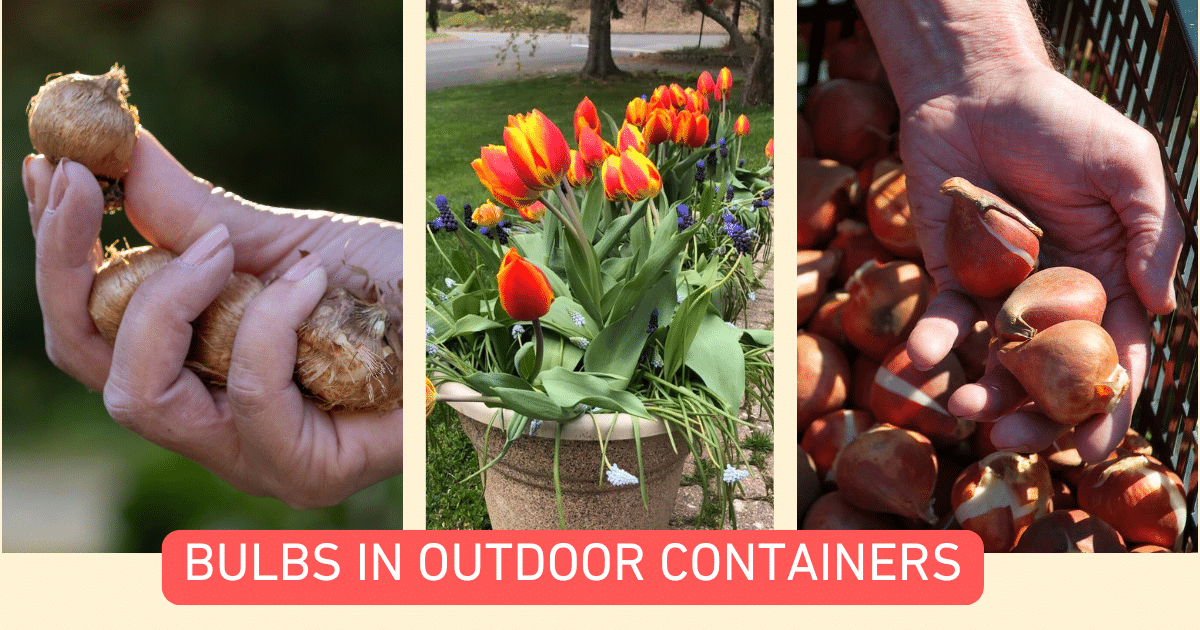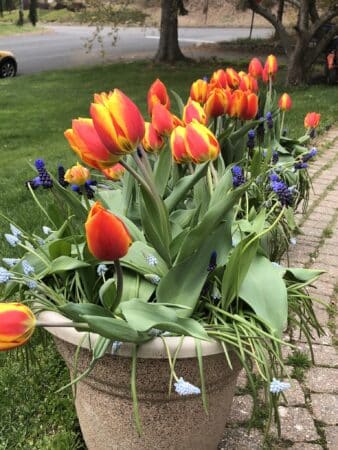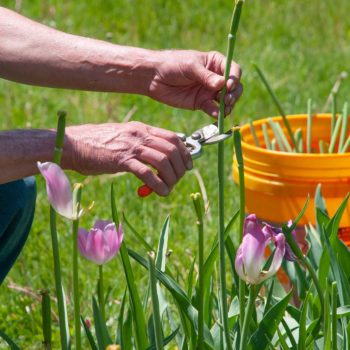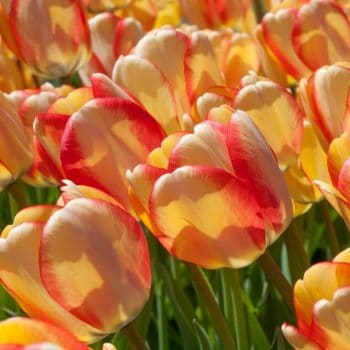
Gardening websites, magazines, and influencers often extol the beauty of spring-flowering bulbs in outdoor containers. They are less forthcoming about planting bulbs in containers and how challenging it can be to achieve the lovely plantings they show.
What’s so difficult about growing bulbs in containers? In a word: temperature. Spring-flowering bulbs need an extended period (3–4 months) of cold—below 45 degrees F but above freezing. If they don’t get enough cold, they will not grow and flower properly. On the other hand, if bulbs are subjected to temperatures below freezing for an extended period, they can be injured or killed.
In most of the United States, a container sitting outdoors in winter will experience highs and lows that are well outside of this Goldilocks temperature range. If the deviation is prolonged or pronounced, the bulbs will not perform as they should. That is why Colorblends does not guarantee bulbs planted in a pot or any other kind of container.
Want to give planting bulbs in containers a try despite the pitfalls? Read on.
When Your Climate Might Be Too Cold
In the northern half of the U.S., where winter temperatures dip well below freezing and stay there for long periods, growing bulbs in outdoor containers is likely to end in failure. Bulbs planted in the ground benefit from the insulation of the earth. The soil may freeze, but the temperature does not fall much below 32 degrees F. The potting mix in a container, by contrast, has a very low insulation value relative to the earth. Cold moving in from the sides, as well as from above, can reduce the temperature of the mix to the point where bulbs are injured or killed.
Bulbs in a container are also subject to rapid temperature fluctuations. The temperature of the ground changes very gradually. It slowly cools in fall and slowly warms in spring. The potting mix in a container can vary with the weather. A warm spell in winter may trick bulbs into “thinking” that spring is coming, with disastrous consequences if severe cold returns.
People with a protected cold space—an attached garage, for example—may be able to grow bulbs in a container successfully. As noted above, the temperature must remain below 45 degrees F but above freezing through winter. The container must also be portable. Once the bulbs push above the surface of the potting mix, they need sunlight to grow properly. When the temperature is above freezing, the container should be moved outdoors. If a hard freeze is expected, the container should be moved back into the protected cold space. This back-and-forth requires extra effort, but the results can be very pleasing. A member of the Colorblends staff has been using this technique for many years.
Note: To monitor temperature, place a thermometer on top of the potting mix. An inexpensive one will work just fine.
When Your Climate Might Be Too Warm
Spring-flowering bulbs need a prolonged period of cold (32–45 degrees F) to grow and flower properly. In the Deep South, the Southwest, and most of California (roughly USDA Zone 7b and warmer), winters are generally too mild to provide this chilling requirement. Bulbs that don’t get enough cold will not perform as advertised. Tulips, for example, may be stunted, flowering at or just above soil level.
It is possible to supplement the cold provided by mother nature through a process called prechilling—placing bulbs in a refrigerator for 6–12 weeks before planting them. (Please see our FAQ on prechilling and our article How to Prechill Spring-Flowering Bulbs for more information on this subject.) Note the word “supplement.” Prechilled bulbs need additional cold after planting to grow correctly. The temperature of the potting mix in an outdoor container mirrors the air temperature much more closely than the ground does. If the air temperature is running warm, bulbs in a container will experience this warmth. To keep the potting mix as cool as possible, a container of bulbs should be placed in a shady location until the foliage emerges. This precaution does not ensure a good result. If winter temperatures are too mild, the bulbs may fail to perform as expected, even if they have been prechilled.
When Your Climate Might Be Just Right
There is a narrow geographic band in which bulbs can be planted in an outdoor container and get the cold they need—without prechilling and without protection from severe winter lows. This band runs, more or less, from Washington, D.C., down to the mountains of North Carolina and west across the southern plains. It meanders through the foothills of the Rockies and continues upward through extreme northern California and ends in the Pacific Northwest. Plant the bulbs in the fall, water them as needed during winter dry spells, and enjoy beautiful flowers in the spring.
Sounds great, for the lucky few. But beware. This band is not well defined. Determining whether one is in the ideal climate for growing bulbs in containers is a matter of guesswork and trial and error. Moreover, winter is a variable thing. It can be relatively mild or relatively severe. It is perfectly possible to have two or three nice spring displays from bulbs in containers and then to experience disappointment or catastrophic failure when the next winter is warmer or colder than previous ones.
Tips on Planting Bulbs in Containers
Undaunted by the risks of planting bulbs in containers? Here is some additional information that might be helpful.
Choose the right container.
Two key factors matter when selecting a container for bulbs: drainage and size. Spring-flowering bulbs need good drainage to thrive. If they sit in soggy potting mix for too long, they will rot and die. Always use a container with a drainage hole at the bottom to let excess water escape.
Larger containers are also better for success. The added mass of potting mix in a big container buffers against temperature swings, reducing the risk of bulbs freezing or overheating. Larger containers retain moisture longer, so you’ll water less often (see “Watering” below). If you need to move the container during extreme weather, opt for a manageable size or use tools like a hand truck or plant dolly for heavy pots.
Pack the bulbs closely.
The basic technique is the same as that used for planting bulbs in the ground, but bulbs in a container can and should be spaced much more closely in a container. It’s OK if the bulbs touch each other. You are assembling a living bouquet. Full is what you want.
Keep the bulbs watered.
Once they are planted, bulbs must not be allowed to dry out. Too little water is as damaging as too much. The initial water requirement of bulbs is quite low; rainfall may be enough to keep the potting mix moist. But when active growth begins (i.e., when the shoots push through the surface of the potting mix), bulbs become very thirsty, and when planted closely in a container, they can quickly take up the available moisture. Check the potting mix frequently. If it is dry to the touch, water thoroughly—until excess water drains out the bottom of the container.
Skip the fertilizer.
Fertilizer is not necessary for spring-flowering bulbs. When you receive them, they already have the following spring’s flowers inside them. All they need is winter cold and access to moisture to do their thing. Also, many potting mixes contain fertilizer. Providing more fertilizer is overkill.
Care for bulbs after bloom.
Life in a container is stressful for bulbs. They are planted close together and must compete with each other for moisture and light. Temperature swings and uneven watering can take a toll on their health. And transplanting bulbs while they are in active growth can disrupt their life cycle, causing them to go dormant earlier than they would if left in peace—perhaps too early to allow the formation of flowers for the following spring. Still, it might be worth moving some bulbs (daffodils and specialty bulbs in particular) into the garden to see if they will settle in and bloom again further down the road.
Note for customers in warm climates: Prechilled bulbs are unlikely to perform well in future springs. It is best to purchase and prechill new bulbs every year.
If you take nothing else from this article, please remember this: Colorblends does not guarantee bulbs planted in a pot or any other kind of container. Planting bulbs in containers is at your own risk.



